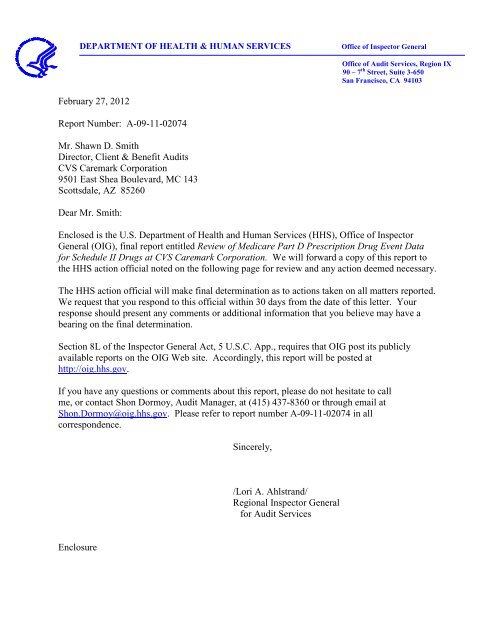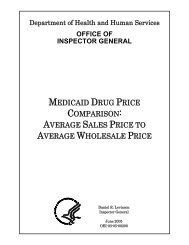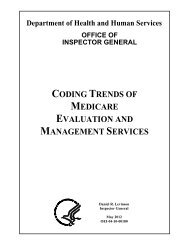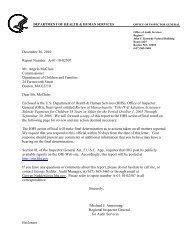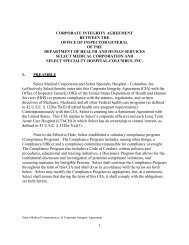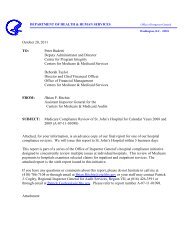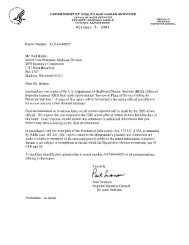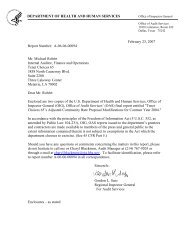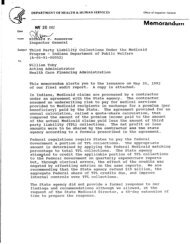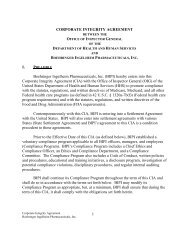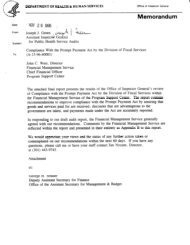Review of Medicare Part D Prescription Drug Event Data for ...
Review of Medicare Part D Prescription Drug Event Data for ...
Review of Medicare Part D Prescription Drug Event Data for ...
- No tags were found...
Create successful ePaper yourself
Turn your PDF publications into a flip-book with our unique Google optimized e-Paper software.
DEPARTMENT OF HEALTH & HUMAN SERVICESOffice <strong>of</strong> Inspector GeneralOffice <strong>of</strong> Audit Services, Region IX90 – 7 th Street, Suite 3-650San Francisco, CA 94103February 27, 2012Report Number: A-09-11-02074Mr. Shawn D. SmithDirector, Client & Benefit AuditsCVS Caremark Corporation9501 East Shea Boulevard, MC 143Scottsdale, AZ 85260Dear Mr. Smith:Enclosed is the U.S. Department <strong>of</strong> Health and Human Services (HHS), Office <strong>of</strong> InspectorGeneral (OIG), final report entitled <strong>Review</strong> <strong>of</strong> <strong>Medicare</strong> <strong>Part</strong> D <strong>Prescription</strong> <strong>Drug</strong> <strong>Event</strong> <strong>Data</strong><strong>for</strong> Schedule II <strong>Drug</strong>s at CVS Caremark Corporation. We will <strong>for</strong>ward a copy <strong>of</strong> this report tothe HHS action <strong>of</strong>ficial noted on the following page <strong>for</strong> review and any action deemed necessary.The HHS action <strong>of</strong>ficial will make final determination as to actions taken on all matters reported.We request that you respond to this <strong>of</strong>ficial within 30 days from the date <strong>of</strong> this letter. Yourresponse should present any comments or additional in<strong>for</strong>mation that you believe may have abearing on the final determination.Section 8L <strong>of</strong> the Inspector General Act, 5 U.S.C. App., requires that OIG post its publiclyavailable reports on the OIG Web site. Accordingly, this report will be posted athttp://oig.hhs.gov.If you have any questions or comments about this report, please do not hesitate to callme, or contact Shon Dormoy, Audit Manager, at (415) 437-8360 or through email atShon.Dormoy@oig.hhs.gov. Please refer to report number A-09-11-02074 in allcorrespondence.Sincerely,/Lori A. Ahlstrand/Regional Inspector General<strong>for</strong> Audit ServicesEnclosure
Department <strong>of</strong> Health and Human ServicesOFFICE OFINSPECTOR GENERALREVIEW OF MEDICARE PART DPRESCRIPTION DRUG EVENT DATAFOR SCHEDULE II DRUGS ATCVS CAREMARK CORPORATIONDaniel R. LevinsonInspector GeneralFebruary 2012A-09-11-02074
Office <strong>of</strong> Inspector Generalhttp://oig.hhs.govThe mission <strong>of</strong> the Office <strong>of</strong> Inspector General (OIG), as mandated by Public Law 95-452, as amended, isto protect the integrity <strong>of</strong> the Department <strong>of</strong> Health and Human Services (HHS) programs, as well as thehealth and welfare <strong>of</strong> beneficiaries served by those programs. This statutory mission is carried outthrough a nationwide network <strong>of</strong> audits, investigations, and inspections conducted by the followingoperating components:Office <strong>of</strong> Audit ServicesThe Office <strong>of</strong> Audit Services (OAS) provides auditing services <strong>for</strong> HHS, either by conducting audits withits own audit resources or by overseeing audit work done by others. Audits examine the per<strong>for</strong>mance <strong>of</strong>HHS programs and/or its grantees and contractors in carrying out their respective responsibilities and areintended to provide independent assessments <strong>of</strong> HHS programs and operations. These assessments helpreduce waste, abuse, and mismanagement and promote economy and efficiency throughout HHS.Office <strong>of</strong> Evaluation and InspectionsThe Office <strong>of</strong> Evaluation and Inspections (OEI) conducts national evaluations to provide HHS, Congress,and the public with timely, useful, and reliable in<strong>for</strong>mation on significant issues. These evaluations focuson preventing fraud, waste, or abuse and promoting economy, efficiency, and effectiveness <strong>of</strong>departmental programs. To promote impact, OEI reports also present practical recommendations <strong>for</strong>improving program operations.Office <strong>of</strong> InvestigationsThe Office <strong>of</strong> Investigations (OI) conducts criminal, civil, and administrative investigations <strong>of</strong> fraud andmisconduct related to HHS programs, operations, and beneficiaries. With investigators working in all 50States and the District <strong>of</strong> Columbia, OI utilizes its resources by actively coordinating with the Department<strong>of</strong> Justice and other Federal, State, and local law en<strong>for</strong>cement authorities. The investigative ef<strong>for</strong>ts <strong>of</strong> OI<strong>of</strong>ten lead to criminal convictions, administrative sanctions, and/or civil monetary penalties.Office <strong>of</strong> Counsel to the Inspector GeneralThe Office <strong>of</strong> Counsel to the Inspector General (OCIG) provides general legal services to OIG, renderingadvice and opinions on HHS programs and operations and providing all legal support <strong>for</strong> OIG’s internaloperations. OCIG represents OIG in all civil and administrative fraud and abuse cases involving HHSprograms, including False Claims Act, program exclusion, and civil monetary penalty cases. Inconnection with these cases, OCIG also negotiates and monitors corporate integrity agreements. OCIGrenders advisory opinions, issues compliance program guidance, publishes fraud alerts, and providesother guidance to the health care industry concerning the anti-kickback statute and other OIG en<strong>for</strong>cementauthorities.
EXECUTIVE SUMMARYBACKGROUNDTitle I <strong>of</strong> the <strong>Medicare</strong> <strong>Prescription</strong> <strong>Drug</strong>, Improvement, and Modernization Act <strong>of</strong> 2003amended Title XVIII <strong>of</strong> the Social Security Act (the Act) by establishing the <strong>Medicare</strong> <strong>Part</strong> Dprescription drug program. Under <strong>Part</strong> D, which began January 1, 2006, individuals entitled tobenefits under <strong>Part</strong> A or enrolled in <strong>Part</strong> B may obtain drug coverage.The Centers <strong>for</strong> <strong>Medicare</strong> & Medicaid Services (CMS), which administers the <strong>Part</strong> D program,contracts with private entities called <strong>Part</strong> D sponsors that act as payers and insurers <strong>for</strong>prescription drug benefits. A <strong>Part</strong> D sponsor may contract with a pharmacy benefits manager(PBM) to manage or administer the prescription drug benefit on the sponsor’s behalf. Pursuantto 42 CFR § 423.505(i), the sponsor maintains ultimate responsibility <strong>for</strong> complying with itscontract with CMS, which includes compliance with all Federal laws, regulations, and guidance.Pursuant to sections 1860D-15(c)(1)(C) and (d)(2) <strong>of</strong> the Act and 42 CFR § 423.322, sponsorsmust submit the in<strong>for</strong>mation necessary <strong>for</strong> CMS to carry out <strong>Part</strong> D payment provisions andprogram integrity activities. For every prescription filled, the <strong>Part</strong> D sponsor or its PBMprepares a <strong>Prescription</strong> <strong>Drug</strong> <strong>Event</strong> (PDE) record and submits it to CMS. Certain fields in thePDE record are completed using in<strong>for</strong>mation provided by the pharmacy responsible <strong>for</strong> fillingthe prescriptions. The PDE record, which is a summary record <strong>of</strong> individual drug claimtransactions at the pharmacy, enables CMS to make payment to the sponsor and otherwiseadminister the <strong>Part</strong> D benefit. Pursuant to 42 CFR § 423.505(k), the sponsor must providecertification as to the accuracy, completion, and truthfulness <strong>of</strong> the claims data submitted <strong>for</strong>payment purposes.The Controlled Substances Act established five schedules based on the medical use acceptanceand the potential <strong>for</strong> abuse <strong>of</strong> the substance or drug. Schedule II drugs have a high potential <strong>for</strong>abuse, have an accepted medical use (with severe restrictions), and may cause severepsychological or physical dependence if abused. Pursuant to 21 CFR § 1306.12(a), Schedule IIprescription drugs may not be refilled. However, 21 CFR § 1306.13(b) provides that Schedule IIdrugs <strong>for</strong> patients residing in a long-term-care facility and <strong>for</strong> the terminally ill may be partiallyfilled as long as the total quantity dispensed does not exceed the total quantity prescribed. Underthis provision, Schedule II prescriptions <strong>for</strong> these patients are valid <strong>for</strong> a period not to exceed60 days from the issue date. In addition, pursuant to 21 CFR § 1306.11, Schedule II drugs maynot be dispensed without a practitioner’s written prescription.CVS Caremark Corporation (Caremark) provided prescription drug benefits to eligible <strong>Part</strong> Dbeneficiaries through its two wholly owned subsidiaries, SilverScript Insurance Company andAccendo Insurance Company, which contracted with CMS as <strong>Part</strong> D sponsors. Caremarkprovided prescription drug coverage to over 389,000 beneficiaries and submitted to CMS over4.2 million PDE records <strong>for</strong> Schedule II drugs <strong>for</strong> dates <strong>of</strong> service from January 1, 2008, throughJune 30, 2010.i
OBJECTIVEOur objective was to determine whether Caremark had adequate controls to (1) prevent refillsand unallowable partial fills <strong>of</strong> Schedule II drugs and (2) ensure the accuracy <strong>of</strong> certain fields inthe PDE records submitted <strong>for</strong> Schedule II drugs.SUMMARY OF FINDINGSCaremark did not have adequate controls to (1) prevent refills and unallowable partial fills <strong>of</strong>Schedule II drugs and (2) ensure the accuracy <strong>of</strong> certain fields in the PDE records submitted <strong>for</strong>Schedule II drugs as required by Federal regulations. Of 42 judgmentally selected PDE records,7 records represented unallowable partial fills. (There were no refills.) In addition, <strong>of</strong>62 judgmentally selected PDE records (which included the 42 records reviewed <strong>for</strong> refills andpartial fills), 24 records contained inaccurate data when compared with the supportingdocumentation at the pharmacies. An additional two PDE records were missing pharmacydocumentation, which prevented us from determining the accuracy <strong>of</strong> the data in the records.The claims processing systems had no edits to identify refills and unallowable partial fills bypharmacies to prevent submission <strong>of</strong> PDE records related to those prescriptions nor did thesystems have edits to ensure the accuracy <strong>of</strong> certain fields in the PDE records. In addition,Caremark has not provided to pharmacies any guidance clarifying Federal requirements relatedto refills and partial fills <strong>of</strong> Schedule II drugs or adequate guidance on submitting accurate claimin<strong>for</strong>mation <strong>for</strong> Schedule II drugs.RECOMMENDATIONSWe recommend that Caremark:• strengthen its controls to (1) prevent refills and unallowable partial fills <strong>of</strong> Schedule IIdrugs and (2) ensure the accuracy <strong>of</strong> submitted PDE records and• issue guidance to its pharmacies clarifying Federal requirements related to (1) refills andpartial fills <strong>of</strong> Schedule II drugs and (2) submission <strong>of</strong> accurate claim in<strong>for</strong>mation <strong>for</strong>Schedule II drugs.AUDITEE COMMENTSIn written comments on our draft report, Caremark did not explicitly concur with ourrecommendations but provided in<strong>for</strong>mation on communication, training, and compliance actionstaken to address the recommendations. Caremark’s comments are included in their entirety asthe Appendix.ii
TABLE OF CONTENTSINTRODUCTION................................................................................................................1BACKGROUND ......................................................................................................1<strong>Medicare</strong> <strong>Part</strong> D .............................................................................................1<strong>Prescription</strong> <strong>Drug</strong> <strong>Event</strong> <strong>Data</strong> ........................................................................1Controlled Substances ....................................................................................1CVS Caremark Corporation, SilverScript Insurance Company, andAccendo Insurance Company ......................................................................2OBJECTIVE, SCOPE, AND METHODOLOGY .....................................................3Objective ........................................................................................................3Scope .............................................................................................................3Methodology ..................................................................................................3FINDINGS AND RECOMMENDATIONS ......................................................................4APPENDIXFEDERAL REQUIREMENTS ..................................................................................5Federal Regulations <strong>for</strong> Schedule II <strong>Drug</strong>s ....................................................5Federal Regulations and Guidance <strong>for</strong> Sponsors ..........................................5REFILLS AND UNALLOWABLE PARTIAL FILLS .............................................5INACCURATE PRESCRIPTION DRUG EVENT DATA ......................................6Inaccurate <strong>Data</strong> ..............................................................................................6Missing Documentation ................................................................................6INADEQUATE CONTROLS ...................................................................................7CONCLUSION ..........................................................................................................7RECOMMENDATIONS ..........................................................................................7AUDITEE COMMENTS ..........................................................................................7AUDITEE COMMENTSPageiii
INTRODUCTIONBACKGROUND<strong>Medicare</strong> <strong>Part</strong> DTitle I <strong>of</strong> the <strong>Medicare</strong> <strong>Prescription</strong> <strong>Drug</strong>, Improvement, and Modernization Act <strong>of</strong> 2003amended Title XVIII <strong>of</strong> the Social Security Act (the Act) by establishing the <strong>Medicare</strong> <strong>Part</strong> Dprescription drug program. Under <strong>Part</strong> D, which began January 1, 2006, individuals entitled tobenefits under <strong>Part</strong> A or enrolled in <strong>Part</strong> B may obtain drug coverage.The Centers <strong>for</strong> <strong>Medicare</strong> & Medicaid Services (CMS), which administers the <strong>Part</strong> D program,contracts with private entities called <strong>Part</strong> D sponsors that act as payers and insurers <strong>for</strong>prescription drug benefits. Sponsors may <strong>of</strong>fer prescription drug benefits through a standaloneprescription drug plan or as part <strong>of</strong> a managed care plan, known as a <strong>Medicare</strong> Advantage<strong>Prescription</strong> <strong>Drug</strong> Plan.A <strong>Part</strong> D sponsor may contract with a pharmacy benefits manager (PBM) to manage oradminister the prescription drug benefit on the sponsor’s behalf. PBM responsibilities vary, butinclude services such as processing and paying prescription drug claims, contracting withpharmacies, and negotiating rebates with drug manufacturers. Pursuant to 42 CFR § 423.505(i),the sponsor maintains ultimate responsibility <strong>for</strong> complying with its contracts with CMS, whichincludes compliance with all Federal laws, regulations, and guidance.<strong>Prescription</strong> <strong>Drug</strong> <strong>Event</strong> <strong>Data</strong>Pursuant to sections 1860D-15(c)(1)(C) and (d)(2) <strong>of</strong> the Act and 42 CFR § 423.322, sponsorsmust submit the in<strong>for</strong>mation necessary <strong>for</strong> CMS to carry out <strong>Part</strong> D payment provisions andprogram integrity activities. For every prescription filled, the <strong>Part</strong> D sponsor or its PBMprepares a <strong>Prescription</strong> <strong>Drug</strong> <strong>Event</strong> (PDE) record and submits it to CMS. The PDE record,which is a summary record <strong>of</strong> individual drug claim transactions at the pharmacy, enables CMSto make payment to the sponsor and otherwise administer the <strong>Part</strong> D benefit. Pursuant to42 CFR § 423.505(k), the sponsor must provide certification as to the accuracy, completion, andtruthfulness <strong>of</strong> the claims data submitted <strong>for</strong> payment purposes.A <strong>Part</strong> D sponsor, or its PBM, completes certain fields in the PDE record using in<strong>for</strong>mationprovided by the pharmacy responsible <strong>for</strong> filling the prescription. A PDE record contains fieldsthat identify (1) the sponsor, beneficiary, physician, pharmacy, drug, prescription referencenumber, and fill number; (2) the dates that the prescription was filled and the PDE record wasprocessed; (3) the prescription drug cost and other payment in<strong>for</strong>mation; and (4) physician’sinstructions on whether generic drugs may be dispensed.Controlled SubstancesThe Controlled Substances Act (CSA), 21 U.S.C. §§ 801–971, established five schedules basedon the medical use acceptance and the potential <strong>for</strong> abuse <strong>of</strong> the substance or drug. Schedule I,1
which includes drugs or substances that have no currently accepted medical use and a highpotential <strong>for</strong> abuse, is the most restrictive, and Schedule V is the least restrictive.Schedule II drugs have a high potential <strong>for</strong> abuse, have an accepted medical use in treatment inthe United States or an accepted medical use with severe restrictions, and may cause severepsychological or physical dependence if abused (21 U.S.C. § 812(b)(2)). Except in emergencysituations or when dispensed directly by a practitioner other than a pharmacist to the ultimateuser, Schedule II drugs may not be dispensed without a practitioner’s written prescription(21 CFR § 1306.11). Schedule II drugs include drugs such as oxycodone and morphine.Pursuant to 21 CFR § 1306.12(a), Schedule II prescription drugs may not be refilled. However,21 CFR § 1306.13(b) provides that Schedule II drugs <strong>for</strong> patients residing in a long-term-carefacility and <strong>for</strong> the terminally ill may be partially filled as long as the total quantity dispenseddoes not exceed the total quantity prescribed. 1 Under this provision, Schedule II prescriptions<strong>for</strong> these patients are valid <strong>for</strong> a period not to exceed 60 days from the issue date.CVS Caremark Corporation, SilverScript Insurance Company, and Accendo InsuranceCompanyCVS Caremark Corporation (Caremark) provided prescription drug benefits to eligible <strong>Part</strong> Dbeneficiaries through its two wholly owned subsidiaries, SilverScript Insurance Company(SilverScript) and Accendo Insurance Company (Accendo), which contracted with CMS as<strong>Part</strong> D sponsors. Accendo was acquired by Caremark in October 2008. Caremark providedprescription drug coverage to over 389,000 beneficiaries and submitted to CMS over 4.2 millionPDE records <strong>for</strong> Schedule II drugs <strong>for</strong> dates <strong>of</strong> service from January 1, 2008, throughJune 30, 2010. For these PDE records, pharmacies were paid approximately $516 million. 2SilverScript and Accendo contracted with CVS Caremark <strong>Part</strong> D Services, LLC (Caremark<strong>Part</strong> D Services) and RxAmerica, LLC (RxAmerica), respectively, to provide PBM services,including claims processing and adjudication, as well as preparation and submission <strong>of</strong> PDErecords. Caremark <strong>Part</strong> D Services and RxAmerica are also wholly owned subsidiaries <strong>of</strong>Caremark. Caremark <strong>Part</strong> D Services maintains SilverScript’s pharmacy network and beginningin April 2009 assumed responsibility <strong>for</strong> maintaining Accendo’s pharmacy network. Be<strong>for</strong>eApril 2009, RxAmerica maintained Accendo’s pharmacy network.As PBMs, Caremark <strong>Part</strong> D Services and RxAmerica processed prescription claims <strong>for</strong>SilverScript and Accendo from pharmacies <strong>for</strong> each drug dispensing event. The PBMs usedtheir respective claim s<strong>of</strong>tware to process prescription claims at the point <strong>of</strong> sale, which includedimplementing a series <strong>of</strong> edits and calculating certain data elements. The PBMs used these dataelements, as well as other <strong>Part</strong> D data, to create the PDE records and submitted the PDE records1 The CSA has an exception to the written prescription requirement <strong>for</strong> Schedule II drug prescriptions written <strong>for</strong>residents <strong>of</strong> long-term-care facilities. A prescription received by fax may serve as the original prescription.2 The amount paid to the pharmacies is on behalf <strong>of</strong> the sponsor, beneficiaries, and third parties. The $516 millionincludes the amounts paid <strong>for</strong> original submissions <strong>of</strong> PDE records as well as any subsequent adjustments.2
to CMS. The PBMs also per<strong>for</strong>med audits <strong>of</strong> the data received from pharmacies. SilverScriptand Accendo maintained an oversight role in the PBMs’ processes.OBJECTIVE, SCOPE, AND METHODOLOGYObjectiveOur objective was to determine whether Caremark had adequate controls to (1) prevent refillsand unallowable partial fills <strong>of</strong> Schedule II drugs and (2) ensure the accuracy <strong>of</strong> certain fields inthe PDE records submitted <strong>for</strong> Schedule II drugs.ScopeWe limited our review to 3,511,180 PDE records <strong>for</strong> dates <strong>of</strong> service from January 1, 2008,through June 30, 2010, representing $425,159,489 paid <strong>for</strong> Schedule II drugs under Caremark’stwo standalone prescription drug plans provided by SilverScript and Accendo. We excludedfrom our review PDE records that were (1) <strong>for</strong> noncovered <strong>Part</strong> D drugs under the prescriptiondrug plan, (2) deleted, (3) plan-to-plan reconciliations, (4) subsequently adjusted, or(5) submitted in a nonstandard <strong>for</strong>mat.We limited our review <strong>of</strong> internal controls to gaining an understanding <strong>of</strong> how Caremarkmaintained and monitored PDE records <strong>for</strong> Schedule II drugs and oversaw pharmacies’ claiming<strong>of</strong> these drugs. We did not review the completeness <strong>of</strong> the PDE records; we limited our review tothe fields in the PDE records that contained data provided by the pharmacies responsible <strong>for</strong>filling the prescriptions.We conducted our audit from May to December 2011 and per<strong>for</strong>med fieldwork at Caremark’s<strong>of</strong>fice in Scottsdale, Arizona, and at selected pharmacies.MethodologyTo accomplish our objective, we:• reviewed applicable Federal laws, regulations, and guidance;• interviewed CMS <strong>of</strong>ficials about the Federal requirements related to Schedule II drugs;• reviewed SilverScript’s and Accendo’s contracts with CMS regarding their roles andresponsibilities as <strong>Part</strong> D sponsors;• reviewed SilverScript’s contract with Caremark <strong>Part</strong> D Services and Accendo’s contractwith RxAmerica regarding pharmacy contracting and processing <strong>of</strong> pharmacy claims;• interviewed Caremark <strong>of</strong>ficials regarding their monitoring and oversight <strong>of</strong> PDE data;3
• obtained SilverScript’s and Accendo’s PDE records <strong>for</strong> Schedule II drugs <strong>for</strong> dates <strong>of</strong>service from January 1, 2008, through June 30, 2010 (processed by CMS throughNovember 2010);• analyzed the PDE records by beneficiary, prescription reference number, and fill numberto determine that 187,989 PDE records represented potential refills and/or potentialunallowable partial fills;• selected a judgmental sample <strong>of</strong> 42 PDE records and reviewed the supportingdocumentation at the pharmacies that submitted those claims to identify refills andunallowable partial fills;• selected a judgmental sample <strong>of</strong> 62 PDE records (which included the 42 PDE recordsreviewed <strong>for</strong> refills and partial fills) and reviewed the supporting documentation at thepharmacies that submitted those claims to determine the accuracy <strong>of</strong> certain fields in thePDE records; and• shared the results <strong>of</strong> our audit with Caremark <strong>of</strong>ficials.We conducted this per<strong>for</strong>mance audit in accordance with generally accepted governmentauditing standards. Those standards require that we plan and per<strong>for</strong>m the audit to obtainsufficient, appropriate evidence to provide a reasonable basis <strong>for</strong> our findings and conclusionsbased on our audit objectives. We believe that the evidence obtained provides a reasonable basis<strong>for</strong> our findings and conclusions based on our audit objective.FINDINGS AND RECOMMENDATIONSCaremark did not have adequate controls to (1) prevent refills and unallowable partial fills <strong>of</strong>Schedule II drugs and (2) ensure the accuracy <strong>of</strong> certain fields in the PDE records submitted <strong>for</strong>Schedule II drugs as required by Federal regulations. Of 42 judgmentally selected PDE records,7 records represented unallowable partial fills. (There were no refills.) In addition, <strong>of</strong>62 judgmentally selected PDE records (which included the 42 records reviewed <strong>for</strong> refills andpartial fills), 24 records contained inaccurate data when compared with the supportingdocumentation at the pharmacies. An additional two PDE records were missing pharmacydocumentation, which prevented us from determining the accuracy <strong>of</strong> the data in the records.The claims processing systems had no edits to identify refills and unallowable partial fills bypharmacies to prevent submission <strong>of</strong> PDE records related to those prescriptions nor did thesystems have edits to ensure the accuracy <strong>of</strong> certain fields in the PDE records. In addition,Caremark has not provided to pharmacies any guidance clarifying Federal requirements relatedto refills and partial fills <strong>of</strong> Schedule II drugs or adequate guidance on submitting accurate claimin<strong>for</strong>mation <strong>for</strong> Schedule II drugs.4
FEDERAL REQUIREMENTSFederal Regulations <strong>for</strong> Schedule II <strong>Drug</strong>sPursuant to Federal regulations (21 CFR § 1306.12(a)), Schedule II prescription drugs may notbe refilled. A separate prescription is required if a physician wishes to authorize continuation <strong>of</strong>a patient’s use <strong>of</strong> a Schedule II drug beyond the amount specified on the first prescription.However, Federal regulations (21 CFR § 1306.13(b)) allow <strong>for</strong> a prescription <strong>for</strong> a Schedule IIdrug written <strong>for</strong> a patient in a long-term-care facility or <strong>for</strong> a patient with a medical diagnosisdocumenting a terminal illness to be filled in partial quantities to include individual dosage units.Under this provision, a Schedule II drug may be partially filled as long as the total quantitydispensed does not exceed the total quantity prescribed. The prescription is valid <strong>for</strong> a period notto exceed 60 days from the issue date. 3Pursuant to 21 CFR § 1306.11, except in emergency situations or when dispensed directly by apractitioner other than a pharmacist to the ultimate user, Schedule II drugs may not be dispensedwithout a practitioner’s written prescription.Federal Regulations and Guidance <strong>for</strong> SponsorsPursuant to 42 CFR § 423.505(d), the sponsor agrees to maintain, <strong>for</strong> 10 years, records anddocuments that are sufficient to accommodate periodic auditing <strong>of</strong> data and to enable inspection<strong>of</strong> the quality, appropriateness, and timeliness <strong>of</strong> services per<strong>for</strong>med under the contract withCMS. In addition, pursuant to 42 CFR § 423.505(k), the sponsor must provide certification as tothe accuracy, completion, and truthfulness <strong>of</strong> the claims data submitted. For every individualdrug claim transaction at the pharmacy, the <strong>Part</strong> D sponsor or its PBM prepares a PDE record.Notwithstanding any relationship that the sponsor may have with related entities, contractors, orsubcontractors, the sponsor maintains ultimate responsibility <strong>for</strong> complying with its contractswith CMS, which includes compliance with all Federal laws, regulations, and CMS instructions(42 CFR § 423.505(i)). In addition, CMS’s <strong>Prescription</strong> <strong>Drug</strong> Benefit Manual, chapter 9,section 50.2.6.3.1, recommends that the sponsor have systems capability to establish edits anduse edits to automatically deny claims or suspend payments on claims when appropriate.REFILLS AND UNALLOWABLE PARTIAL FILLSOf 42 judgmentally selected PDE records, 7 records represented unallowable partial fills <strong>of</strong>Schedule II drugs. (There were no refills.)• For three PDE records, the drug was dispensed more than 60 days after the issue date <strong>of</strong>the prescription.3 Federal regulations (21 CFR § 1306.13(a)) also permit the partial filling <strong>of</strong> a prescription <strong>for</strong> a Schedule II drug ifthe pharmacist is unable to supply the full quantity prescribed. The remaining portion <strong>of</strong> the prescription may befilled within 72 hours <strong>of</strong> the first partial filling; however, if the remaining portion is not or cannot be filled withinthe 72-hour period, the pharmacist may not dispense any further quantity without a new prescription.5
• For four PDE records, the drug was dispensed without a practitioner’s writtenprescription.INACCURATE PRESCRIPTION DRUG EVENT DATAOf 62 judgmentally selected PDE records (which included the 42 records reviewed <strong>for</strong> refills andpartial fills), 24 records contained inaccurate data. An additional two PDE records were missingpharmacy documentation, which prevented us from determining the accuracy <strong>of</strong> the data in therecords.Inaccurate <strong>Data</strong>We considered data to be inaccurate when certain fields in the PDE records did not match thesupporting documentation that we reviewed at the pharmacies. The 24 PDE records containedthe following inaccurate data: 4• The prescription date <strong>of</strong> service did not match the date that the prescribed drug wasactually dispensed to the beneficiary.• The National <strong>Drug</strong> Code did not match the drug that was actually dispensed by thepharmacy.• The fill number did not match the number <strong>of</strong> refills or partial fills associated with theprescription as shown in the documentation maintained at the pharmacy.• The days supply <strong>of</strong> the drug did not match the days supply <strong>of</strong> the drug actually dispensedby the pharmacy based on the prescriber’s directions <strong>for</strong> use written on the prescription.• The prescriber identifier did not match the prescriber in<strong>for</strong>mation on the prescriptionmaintained at the pharmacy.• The prescription origin code did not match the type <strong>of</strong> prescription that was presented atthe pharmacy (i.e., written, telephone, electronic, or fax).Missing DocumentationOf 62 judgmentally selected PDE records, 2 records were not supported by physician-signedprescriptions. The pharmacy was not able to provide us with any supporting documentation,such as physician-signed prescriptions, refill requests, or drug delivery receipts. There<strong>for</strong>e, wewere not able to determine the accuracy <strong>of</strong> the data in the PDE records.4 All 24 PDE records had at least one <strong>of</strong> the types <strong>of</strong> inaccurate data shown.6
INADEQUATE CONTROLSThe policies and procedures <strong>of</strong> the PBMs—Caremark <strong>Part</strong> D Services and RxAmerica—includedthe use <strong>of</strong> edits in their claims processing systems to identify discrepancies and errors inpharmacy claims. However, there were no edits to identify pharmacies’ refills and unallowablepartial fills. In addition, the PBMs’ edits did not ensure the accuracy <strong>of</strong> certain fields in the PDErecords based on in<strong>for</strong>mation provided by the pharmacies.Caremark <strong>Part</strong> D Services and RxAmerica send correspondence to their network pharmacies onoperational and procedural issues related to claims processing. However, neither PBM hasprovided to pharmacies any guidance clarifying Federal requirements related to refills and partialfills <strong>of</strong> Schedule II drugs or adequate guidance on submitting accurate claim in<strong>for</strong>mation <strong>for</strong>Schedule II drugs.CONCLUSIONSchedule II drugs have a high potential <strong>for</strong> abuse. There<strong>for</strong>e, having adequate controls to preventrefills and unallowable partial fills, while ensuring that an adequate and uninterrupted supply isavailable <strong>for</strong> legitimate medical needs, is a valuable program integrity safeguard. In addition,having adequate controls to ensure the accuracy <strong>of</strong> data in submitted PDE records is essential toprogram integrity. Without adequate controls, <strong>Part</strong> D sponsors cannot properly oversee thedispensing and monitoring <strong>of</strong> Schedule II drugs.RECOMMENDATIONSWe recommend that Caremark:• strengthen its controls to (1) prevent refills and unallowable partial fills <strong>of</strong> Schedule IIdrugs and (2) ensure the accuracy <strong>of</strong> submitted PDE records and• issue guidance to its pharmacies clarifying Federal requirements related to (1) refills andpartial fills <strong>of</strong> Schedule II drugs and (2) submission <strong>of</strong> accurate claim in<strong>for</strong>mation <strong>for</strong>Schedule II drugs.AUDITEE COMMENTSIn written comments on our draft report, Caremark did not explicitly concur with ourrecommendations but provided in<strong>for</strong>mation on communication, training, and compliance actionstaken to address the recommendations. Caremark’s comments are included in their entirety asthe Appendix.7
APPENDIX
Page2<strong>of</strong>2S[LVEI1SCRIPT1. T"" natio
NoticesTHIS REPORT IS AVAILABLE TO THE PUBLICat http://oig.hhs.govSection 8L <strong>of</strong> the Inspector General Act, 5 U.S.C. App., requiresthat OIG post its publicly available reports on the OIG Web site.OFFICE OF AUDIT SERVICES FINDINGS AND OPINIONSThe designation <strong>of</strong> financial or management practices asquestionable, a recommendation <strong>for</strong> the disallowance <strong>of</strong> costsincurred or claimed, and any other conclusions andrecommendations in this report represent the findings andopinions <strong>of</strong> OAS. Authorized <strong>of</strong>ficials <strong>of</strong> the HHS operatingdivisions will make final determination on these matters.


